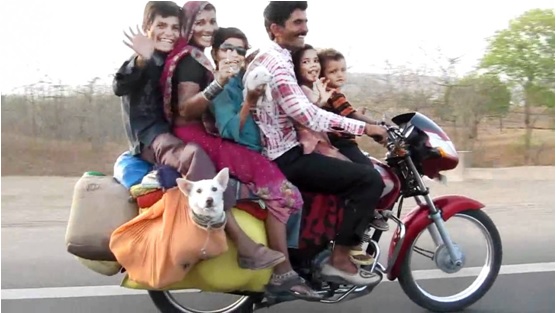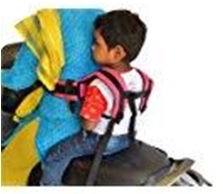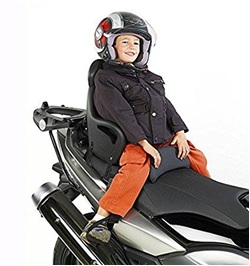Image courtesy: afrycze
A baby born in India almost never leaves his mother’s loving arms. The image of a mother feeding a fussy baby on her hip, distracting him with the sights and sounds on the street, is quintessentially an Indian one. Unlike in the West, we eschew prams, high chairs and baby baths in favour of holding our babies and toddlers as we take them shopping, give them their dinner or a bath.
Is this the same approach that we use then when we ride with our children or drive them around the city? Because if we believe that the safest place for a baby is in his mother’s arms, even as we are thundering down the NH8 on a Hero Honda, baby balanced precariously between mum and dad, mother’s saree whipping her around her face, as a host of vehicles overtake the threesome, most too fast and too close for comfort - we are wrong.
In 2015, 15,633 children were killed in road accidents. Despite the statistics, we continue to travel like we did 20 years ago; toddler lodged between parents on a bike or a dad riding his motorcycle with four little children riding pillion, all helmetless or a child free to move around inside an SUV as it weaves through traffic, driven by perhaps, a poorly trained and aggressive driver. In the same year 2,128 children were victims of cognizable crimes in India. It is true that India runs a much higher risk of losing her children on the road than to murderers.
Child safety on motorbikes
How safe is a child on a motorbike? The American Academy of Paediatrics recommends that children under the age of one should not be a passenger even on a bicycle; infants do not have the muscle strength to seat themselves unsupported. Secondly, even helmets made to size, could potentially increase the risk for cervical spine injuries because of their relatively large heads and poor muscle tone. But in India, riding a motorcycle is a question of economy and practicality. What innovations are out there, that will make that journey safer for our children?
Child seats and harnesses
A motorised tricycle, not unlike those used by people with disabilities, but with a wider seat for seating children designed in China is a promising development for transporting children and families. A vehicle such as this might combine safety and stability together with economy.
Another innovation, targeting the child’s ability to stay on the motorbike even when sleepy or tired is the kid’s safety belt or a riding belt. The belt attaches the child to the rider through a series of interlocking straps. These are now commercially available in the Indian market.
A kangaroo harness (Courtesy: amazon.co.in)
Foot entrapment in wheel spokes is a common injury in children riding pillion on bikes. While motorbikes are supplied with footpegs or footrests, these are typically designed for adults and too low for toddlers or preschoolers to use effectively. In Europe, to facilitate a child riding pillion on a bike, motorcycle child seats are commercially available. The seat varies with the design and type of motorbike and come attached with foot pegs and a harness, securely attaching the child to the vehicle. Such saddles are not yet available in the Indian market, maybe because of prohibitive costs.
Child motorcycle seat (courtesy: amazon.co.uk)
Child helmets
According to WHO’s injury surveillance system operating in South East Asian countries, almost all motorcycle injuries in children were in non-helmet users (95.7% in India in 2007). Several countries have standardised acceptable crash test findings in paediatric helmets which are subsequently enforced by the governments. In India, while the ISI has released standards for adult helmets, none have been formalised for child sized ones. In terms of Indian legislation, the newly prepared Motor Vehicles (Amendment) Act, makes helmets compulsory for children over the age of 4, though it remains silent on the transport of children under 4. It is important that some provision is built into legislation as it is inevitable that a newborn infant within a few days or weeks of her birth, will be making journeys on a motorbike; and we need solutions, quickly.
Child safety in cars
Travelling in cars, on account of the vehicle’s stability, is considered safer than riding a two wheeler. Even until 30 years ago, car seats were not mandatory for children. It was not until the 70’s that advocacy for children’s safety began making an impact and car seats designed to withstand impact were created. In 1979, a study was published in America which proved that adults are not capable of restraining a child in their laps even in the case of low speed crashes. Thirty years on, car seat designs and their crash features are constantly being tested and improved on. These are again mandated by standardising agencies such as the UN Economic Commission for Europe (UN ECE) in the EU.
General standards for seating children in cars in Europe include: a child must be in a rear facing seat until 15 months of age. After this, the child can be in a forward facing seat. The child must use a car seat until 12 years old, after which they must use the car’s seatbelt, when in both front and rear seats.
India has again lagged behind in this respect. The ISI has not issued standards for car seats. Even though car seats are commercially available, manufactured to foreign standards, they remain unpopular, as parents are unaware of the risks of driving with their child unrestrained and the legislation enforcing this has not yet taken effect. Again, with no guidance from the government, it is incumbent on parents to carry out the research, almost intuitively making important decisions that will affect their child’s life and safety.
Conclusion
We can no longer be complacent about our own safety or that of our children when on the road. While few would leave their children unprotected against malaria or a murderer, several thousands of parents unwittingly leave their child unprotected against the biggest killer of our modern times – road crashes. It is important that the public becomes better informed and more willing to change its on-road behaviour.



Add new comment